| Shepherd tree | |
|---|---|
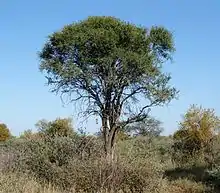 | |
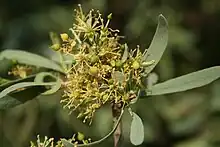 | |
| Scientific classification | |
| Kingdom: | Plantae |
| Clade: | Tracheophytes |
| Clade: | Angiosperms |
| Clade: | Eudicots |
| Clade: | Rosids |
| Order: | Brassicales |
| Family: | Capparaceae |
| Genus: | Boscia |
| Species: | B. albitrunca |
| Binomial name | |
| Boscia albitrunca | |
Boscia albitrunca, commonly known as the shepherd tree or shepherd's tree (Afrikaans: Witgat, Sotho: Mohlôpi, Tswana: Motlôpi, Venda: Muvhombwe, Xhosa: Umgqomogqomo, Zulu: Umvithi), is a protected species of South African tree in the caper family.[1] It is known for having the deepest known root structure of any plant at 68 metres (223 ft).[2]
The species epithet "albitrunca" refers to the white trunk it oftentimes develops. Traditionally, the shepherd tree was used by Dutch settlers, boers, to create a variant of coffee from the roots of the tree.[3] It is an evergreen tree native to southern and tropical Africa, living in the hot, dry, and often seasonally brackish low-lying areas, sometimes on abundant lime or occasionally on rocky terrain. It is a common tree of the Kalahari, bushveld and lowveld. It is one of the most important animal forage trees in the Kalahari.[4]
Description
This tree grows up to 10 m (33 ft) tall but is usually much smaller. It has a prominent, sturdy white trunk frequently with strips of rough, dark-coloured bark. The crown is often browsed by antelope and any grazers capable of reaching the foliage, resulting in a conspicuous flattened underside, or browse-line. The leaves are narrow, oblanceolate, and stiff, with veins obscure except for the distinct midrib. The flowers are small, greenish-yellow, lacking petals, starburst-shaped, and clustered. The fruits, on a jointed stalk, are about 10 mm (0.4 in) in diameter and are brittle-skinned with a whitish flesh and large endocarp. A specimen found in the central Kalahari in 1974 had roots extending to 68 m (223 ft) deep, making it the plant with the deepest known roots thus far found.[2]
Relationships
Boscia belongs to the caper family, Capparaceae. Boscia albitrunca is closely related to Boscia foetida subsp. rehmanniana, the bushveld shepherd's tree, which has much smaller leaves and velvet-textured skin on its fruits. The genus was named for Louis Bosc (1759–1828), a French professor of agriculture who lived through the French Revolution.
Gallery
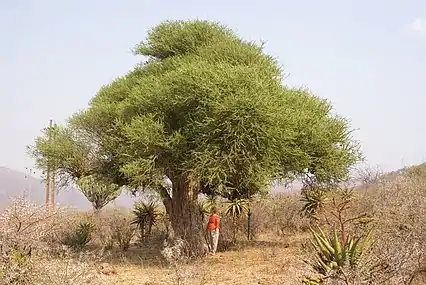 Specimen with a clear browse line, Limpopo
Specimen with a clear browse line, Limpopo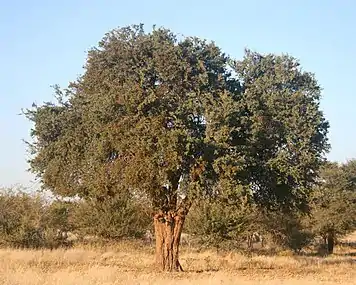 Specimen with its canopy infested with red-berry mistletoe, Limpopo
Specimen with its canopy infested with red-berry mistletoe, Limpopo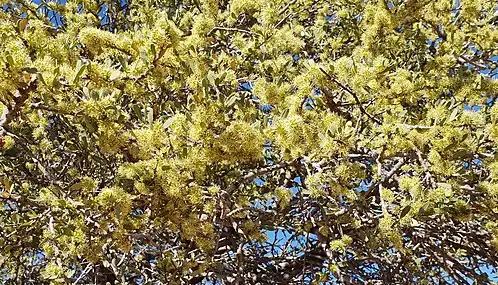 Flowering during late winter, Limpopo
Flowering during late winter, Limpopo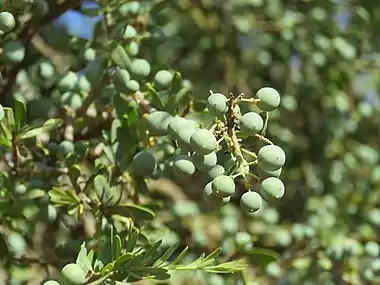 Green fruit during spring, Kalahari
Green fruit during spring, Kalahari_eating_a_fruit_of_a_Shepherd's_Tree_(Boscia_albitrunca)_(45181194105).jpg.webp) Ripe fruit consumed by a cape starling, early summer, Kgalagadi
Ripe fruit consumed by a cape starling, early summer, Kgalagadi
References
- ↑ "Protected Trees" (PDF). Department of Water Affairs and Forestry, Republic of South Africa. 3 May 2013. Archived from the original (PDF) on 2010-07-05.
- 1 2 Canadell, J.; R. B. Jackson; J. B. Ehleringer; H. A. Mooney; O. E. Sala; E.-D. Schulze (18 July 1996). "Maximum rooting depth of vegetation types at the global scale". Oecologia. 108 (4): 583–595. doi:10.1007/BF00329030. PMID 28307789. S2CID 2092130.
- ↑ "Boscia albitrunca | PlantZAfrica". pza.sanbi.org. Retrieved 2023-08-27.
- ↑ Havenga, C. J.; van Niekerk, W. A.; Rethman, N. F. G.; Coertze, R. J. (2004). "Certain qualitative characteristics of Boscia foetida at different sites in South Africa" (PDF). South African Journal of Animal Science (34): 62–64. Archived from the original (PDF) on 16 August 2016. Retrieved 18 May 2016.
- "Boscia albitrunca". PlantZAfrica.com. Retrieved 2010-03-04.
External links
- Dressler, S.; Schmidt, M. & Zizka, G. (2014). "Boscia albitrunca". African plants – a Photo Guide. Frankfurt/Main: Forschungsinstitut Senckenberg.